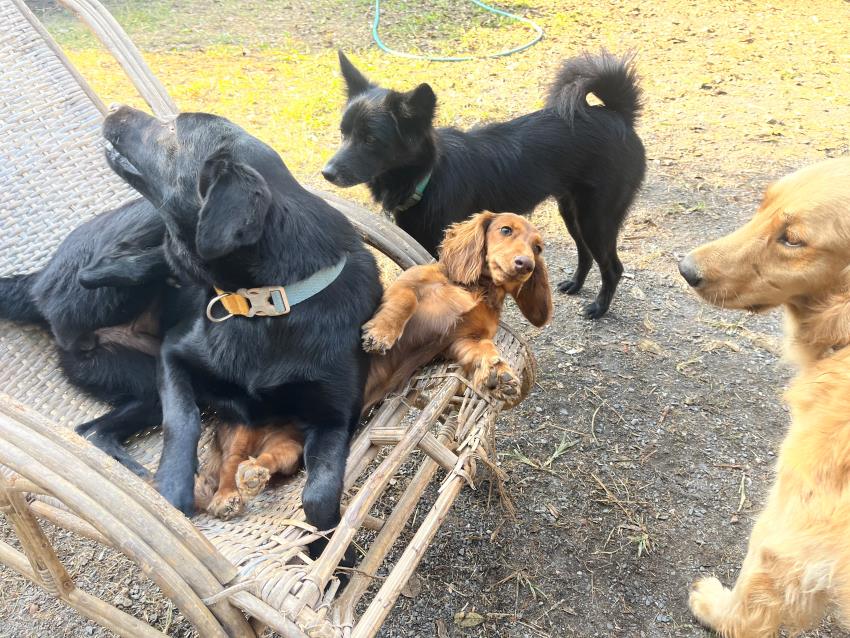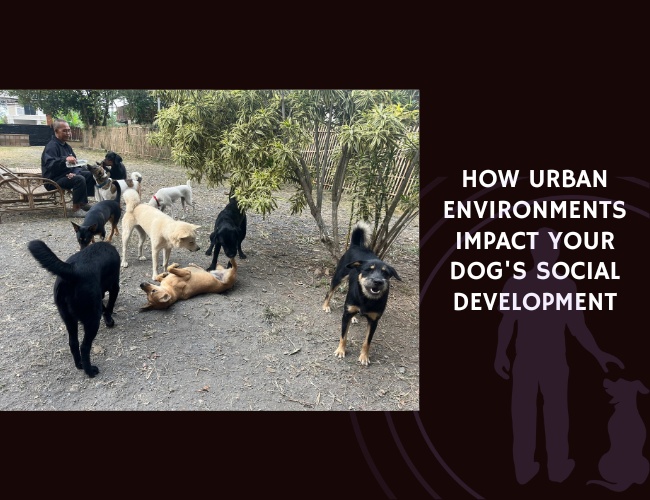Understanding Urban Dog Behavior
Introduction to How Urban Environments Shape Dog Behavior
Urban environments are vastly different from rural areas, and these differences can significantly affect dog behavior. The hustle and bustle of city life, with its constant noise, crowded spaces, and myriad stimuli, can shape dogs’ reactions and interactions in ways that differ from their rural counterparts. In cities, dogs are exposed to more varied and frequent sights, sounds, and smells, contributing to their unique behavioral adaptations.
Living in an urban setting can mean a lot more interactions with strangers—both human and canine—requiring dogs to develop social skills that accommodate these frequent encounters. Urban dogs often navigate crowded sidewalks, deal with loud vehicles, and even use elevators. These experiences differentiate their behavior compared to dogs in rural settings, who may have more freedom to roam and face less environmental stress.
Environmental Influences on Canine Behavior
The environment plays a crucial role in shaping a dog’s behavior, particularly in urban settings where the stimuli are vastly different from rural areas. Urban environments are characterized by constant noise, crowded spaces, and limited natural areas, all of which can significantly impact a dog’s mental and physical well-being. Dogs thrive in environments that provide adequate mental and physical stimulation; however, the urban landscape often presents challenges in meeting these needs.
In cities, dogs are frequently exposed to overwhelming stimuli such as traffic noise, construction sounds, and a high density of people and animals. This constant exposure can lead to increased alertness or, conversely, desensitization over time. The lack of adequate exercise and social interaction in urban settings can result in boredom and frustration, leading to destructive behaviors like chewing, digging, and excessive barking. Therefore, understanding how the environment affects a dog’s behavior is essential for urban dog owners to create a balanced and enriching living space for their pets.
Moreover, the urban environment’s impact on a dog’s social development cannot be overstated. Dogs in cities often encounter more strangers—both human and canine—requiring them to develop robust social skills. However, these frequent interactions can also lead to stress and anxiety if not managed properly. Urban dogs may need to adapt to walking on-leash more often, which can sometimes result in leash reactivity, characterized by lunging, barking, or growling at other dogs or people. By recognizing these environmental influences, dog owners can better support their pets’ social and behavioral needs, ensuring a harmonious coexistence in bustling city life.
Key Differences Between Urban and Rural Dog Behavior Patterns
Dogs residing in urban areas often show different behavior patterns from those living in rural environments:
- Exposure to Stimuli: Urban dogs are continuously exposed to various stimuli, such as traffic noise, construction sounds, and a higher density of people and animals. This could lead to increased alertness or, in some cases, desensitization over time.
- Social Interactions: Urban dogs generally have more chances to meet new people and animals, which can enhance their social skills. However, these encounters may also lead to overstimulation or stress if not managed well.
- Physical Activity: Dogs in rural areas often have more space to run and explore, which can lead to more physical exercise and natural behaviors such as digging or hunting. Urban dogs may rely more on structured activities, like walks and visits to dog parks, which could limit their natural foraging and roaming behaviors.
- Behavioral Responses: In urban settings, dogs might develop coping mechanisms such as ignoring certain stimuli to avoid stress. Conversely, rural dogs may not require such adaptations due to the generally quieter and less crowded environment.
The Concept of Behavioral Plasticity in Urban Dogs
Behavioral plasticity refers to the ability of an animal to modify its behavior in response to changes in the environment. Urban dogs often exhibit a high degree of behavioral plasticity as they adjust to the city’s constant changes and stimuli.
- Adaptation to Noise: Urban dogs might become accustomed to loud noises, reducing their sensitivity over time. This adaptability is crucial for their well-being since constant stress from noise can lead to anxiety and other health issues.
- Social Flexibility: With exposure to various social situations, urban dogs can develop flexible social behaviors. They learn to distinguish between friendly encounters and potential threats, helping them navigate the diverse social landscape of the city.
- Routine Adjustments: Dogs in urban environments may become accustomed to rigid routines due to their owners’ schedules and the confines of city living. Behavioral plasticity allows them to adjust to these routines, helping them remain calm and well-behaved despite the structured environment.
Understanding how urban environments shape dog behavior helps us provide better care and improve their quality of life. Knowing the key differences in behavior and embracing the concept of behavioral plasticity can help urban dog owners foster a supportive, enriching environment for their furry companions.
Understanding Territorial Behaviors in Urban Dogs
Urban environments can significantly influence the territorial behaviors of dogs kept in domestic settings. In these bustling areas, dogs often encounter a variety of stimuli that can trigger their instinctual need to protect their territory. This behavior is deeply rooted in their survival instincts, where guarding their home, family members, and possessions becomes paramount. In urban settings, this can manifest as barking at strangers passing by the window, growling at unfamiliar noises, or even lunging at other dogs during walks. These behaviors are not only natural but also serve as a means for dogs to establish boundaries within their perceived territory. Moreover, the limited space and high density of people and animals in cities can exacerbate territorial behaviors. Dogs may feel the need to assert control over their immediate environment, leading to increased vigilance and sometimes aggressive displays. This can include scent marking, guarding specific areas of the home, or becoming possessive over toys and food. Understanding these behaviors is crucial for urban dog owners, as it allows them to implement strategies to manage and mitigate potential issues effectively. To address these territorial behaviors, urban dog owners can focus on training and socialization. Gradually exposing dogs to different environments and rewarding calm behavior can help reduce territorial aggression. Utilizing commands like “leave it” and ensuring consistency in training can also be beneficial. Additionally, creating a structured routine and providing ample mental and physical stimulation can help alleviate the stressors that contribute to territorial behaviors, promoting a more harmonious coexistence in urban settings.
Social Interaction Patterns
Urban environments offer a dynamic setting for dogs, where social interactions are both frequent and diverse. The impact of this social exposure can shape and modify their behavior and social skills in profound ways.
Frequency and Diversity of Social Encounters
Dogs in urban settings generally experience a higher frequency and diversity of social encounters compared to those in rural areas. These encounters can happen on daily walks, in neighborhood parks, or in dog-friendly establishments. Urban dogs might regularly meet various people—children, adults, elderly individuals—each presenting different social cues and behaviors. Additionally, they can interact with other pets, including dogs of various breeds and even different species like cats.
This diversity fosters a broad range of social experiences, helping urban dogs develop flexible social skills. They learn to read and respond to a wide array of body language signs and social overtures. This adaptability can be a significant advantage, as these dogs can manage and enjoy interactions in different settings.

How Increased Human and Animal Interactions Affect Social Development
The constant exposure to a multitude of social stimuli, from the mail carrier to other dogs in a dog park, accelerates the social development of urban dogs. These interactions help urban dogs to:
- Become More Socially Adept: Regular exposure to various social situations helps dogs become more comfortable and confident around strangers, both human and animal.
- Improve Communication: Dogs that meet a variety of other dogs and people regularly become more skilled at reading social cues and responding appropriately.
- Boost Cognitive Skills: Navigating complex social environments can help enhance dogs’ problem-solving abilities and mental flexibility.
However, these benefits come with challenges. Overexposure to social situations without adequate rest can lead to exhaustion and stress, especially if the encounters are not always positive. Dog owners need to manage social interactions thoughtfully to ensure a balance between social growth and stress management.
The Impact of Controlled versus Spontaneous Social Interactions
Urban environments provide both controlled and spontaneous social interactions. Controlled interactions, such as dog training classes or scheduled playdates, allow for structure and supervision, ensuring that the experiences are positive and reinforcing. These settings help dogs learn appropriate social behaviors in a safe environment, which can be particularly beneficial for puppies or dogs with previous negative social experiences.
On the other hand, spontaneous social interactions—those that happen unplanned, like meeting another dog on a walk—are equally important. They teach dogs to be adaptable and manage unexpected social situations gracefully. However, the unpredictable nature of these encounters can sometimes lead to stress or anxiety, especially if the dog’s social skills are still developing.
The key to positive social development in urban dogs lies in balancing these types of interactions. Controlled environments allow for skill-building and confidence-boosting, while spontaneous interactions help dogs apply these skills in real-world settings. Ensuring that dogs have varied and frequent social encounters, within a framework of thoughtful management, supports their social development and helps them thrive in diverse urban environments.
Managing the balance between these interactions is crucial for your dog’s well-being. Urban dogs need not only the opportunity to enhance their social skills but also the time to rest and relax in a less stimulating environment. This equilibrium will prepare them for varied social settings, aiding their overall development.
Moving forward, understanding and addressing common urban stressors is essential to maintaining your dog’s well-being and promoting a positive urban experience.
Stress Factors and Management
Common Urban Stressors Affecting Dogs
Urban environments can be full of excitement, but they also come with a unique set of stressors for dogs. As cities are bustling hubs of activity, dogs may find it challenging to navigate these spaces without encountering stress. Here are some common urban stressors:
- Noise: Urban areas are often filled with constant noise from traffic, construction, and large groups of people. This continuous auditory bombardment can be overwhelming for dogs, causing anxiety and fear responses.
- Crowding: High population density means more encounters with strangers and other animals. While some dogs can handle these interactions well, others may find them stressful and unsettling.
- Limited Space: Urban living often means smaller homes and limited access to outdoor areas. Dogs that lack sufficient space to exercise and roam freely may experience stress due to pent-up energy and the inability to engage in natural behaviors.
Physiological Indicators of Stress in Urban Dogs
Recognizing the signs of stress in your dog is crucial for managing their well-being. Here are some common physiological indicators of stress:
- Panting and Salivation: Dogs may pant excessively or drool more than usual when they are stressed.
- Pacing and Restlessness: A stressed dog might find it difficult to settle down, frequently changing positions or moving around without apparent purpose.
- Changes in Appetite: Stress can lead to a decrease in appetite or, sometimes, excessive eating.
- Shaking and Trembling: Visible shaking or trembling is a clear sign of stress, often accompanied by other behaviors such as whining or hiding.
- Gastrointestinal Issues: Symptoms like diarrhea or vomiting can also indicate stress, as the digestive system is closely linked to emotional states.
Strategies for Managing and Reducing Urban-Related Stress
Helping your dog manage stress is essential for maintaining their health and happiness. Here are some strategies to consider:
- Create a Safe Space: Designate a quiet area in your home where your dog can retreat when they feel overwhelmed. This space should be comfortable and free from loud noises and disturbances.
- Regular Exercise: Ensure your dog gets plenty of physical activity. Regular walks in less crowded areas and engaging in play can help burn off excess energy and reduce anxiety.
- Training and Socialization: Gradual exposure to urban environments through controlled socialization can help build your dog’s confidence. Positive reinforcement training can also teach your dog to remain calm in stressful situations.
- Routine and Consistency: Maintaining a consistent routine helps establish a sense of security for your dog. Regular meal times, walks, and bedtime can provide predictable structure.
- Calming Products and Interventions: Consider using products designed to alleviate stress, such as calming collars or pheromone diffusers. In some cases, consulting a veterinarian for additional support or medication may be beneficial.
By understanding the sources of stress and employing these strategies, you can help your dog adapt to urban environments and live a more relaxed and happy life.
Now that we have a better grasp of managing stress factors for urban dogs, it’s essential to focus on their overall welfare and available resources to ensure they thrive in city settings.

Urban Welfare Considerations
Common Welfare Challenges in Urban Environments
Living in an urban environment presents unique welfare challenges for dogs. Awareness of these challenges can help dog owners take proactive steps to ensure their pet’s well-being.
- Noise Pollution: City noises (traffic, construction, crowds) can be overwhelming for dogs. Chronic exposure may lead to anxiety, aggression, or noise phobia. Noticing signs of stress, like excessive barking or trembling, can indicate noise sensitivity.
- Limited Space: Urban living often means smaller living spaces and fewer opportunities for off-leash exercise. Lack of physical and mental stimulation can lead to behavioral issues such as chewing, digging, or hyperactivity.
- Air Quality: Poor air quality is a significant concern in many cities. Prolonged exposure to pollutants can impact a dog’s respiratory health, exacerbating conditions like asthma or bronchitis.
- Paved Surfaces: Frequent walking on hard surfaces (concrete, asphalt) can cause paw injuries and joint stress. Ensuring your dog has proper footwear or choosing softer walking paths can mitigate these issues.
- Crowded Spaces: High population density means frequent encounters with humans and other dogs, which can be stressful, especially for dogs not well-socialized.
Access to Resources and Veterinary Care
Urban settings can offer enhanced access to veterinary care, but they also come with their own set of challenges.
- Veterinary Clinics: Cities usually have numerous veterinary clinics, ensuring readily available medical care. However, choosing the right vet and scheduling timely appointments can be challenging due to high demand.
- Pet Supplies: Urban areas typically have a wide array of pet stores, making it easier to find specialized foods, toys, and other essentials. Online delivery services can also fill gaps for hard-to-find items.
- Exercise and Enrichment: Access to parks or designated dog runs is vital for physical exercise. For mental stimulation, consider puzzle toys, training sessions, and scheduled playdates with other dogs.
- Grooming Services: Regular grooming is essential to a dog’s health. Urban areas offer numerous professional grooming services, which can help maintain your dog’s coat and nails while also checking for skin issues.
The Role of Community Support in Urban Dog Welfare
Community support plays a crucial role in ensuring the welfare of urban dogs. Establishing a network within your neighborhood can foster a supportive environment for both dogs and owners.
- Neighborhood Groups: Many urban areas have community groups or online forums where dog owners can share advice, arrange meet-ups, and offer support. Joining these groups can provide valuable information and foster a sense of camaraderie.
- Dog Walkers and Sitters: Professional dog walking and sitting services are more prevalent in urban areas, providing essential support for busy owners. Reliable services can offer peace of mind, ensuring your dog gets the necessary exercise and social interaction.
- Training Classes: Urban areas often have multiple training facilities offering classes ranging from basic obedience to advanced behavioral training. These classes help dogs adapt better to urban living and social interactions.
- Community Events: Many cities host dog-friendly events, such as pet fairs, charity runs, or local dog meet-ups. Participating in these activities can enhance your dog’s socialization and provide engagement for both you and your pet.
Understanding and addressing the unique welfare challenges urban dogs face ensures they live a happy, healthy life. With adequate resources, veterinary care, and community support, you can help your dog thrive in an urban environment.
Positive Adaptation Strategies
City life can be exhilarating, yet it offers its own unique set of challenges for dogs. However, with the right strategies, dogs can not only adapt but thrive in urban environments. This chapter explores how to build behavioral flexibility, leverage urban benefits for social development, and create positive socialization opportunities for your furry friend.
Building Behavioral Flexibility in Urban Environments
Behavioral flexibility is key for urban dogs to thrive amidst the hustle and bustle of the city.
- Gradual Exposure: Gradually exposing your dog to various urban stimuli can help them become accustomed to the sights and sounds of the city. Start with quieter parks before moving to busy streets.
- Positive Reinforcement: Reward your dog with treats and praise when they respond calmly in new environments. This reinforces positive behavior and builds confidence.
- Routine Variations: Introduce small variations in daily routines. This may include taking different routes during walks or visiting new parks. Such changes can help your dog become more adaptable.
Leveraging Urban Benefits for Social Development
Cities offer unique opportunities for dogs to enhance their social skills.
- Dog Parks and Daycare: Utilize urban dog parks and doggy daycare centers. These venues offer controlled settings for your dog to interact with others, facilitating positive social experiences.
- Training Classes: Enroll in urban dog training classes, which often cater specifically to the challenges dogs face in city environments. These classes teach essential skills for coping with urban stressors.
- Social Outings: Include your dog in social outings like dog-friendly cafes or pet events. This not only provides social interaction for your dog but also helps them become comfortable in various social settings.
Creating Positive Socialization Opportunities
Ensuring that your dog has positive socialization experiences is vital in an urban setting.
- Controlled Playdates: Arrange playdates with other dogs in controlled environments. Gradually introduce your dog to new friends, ensuring every interaction is positive and stress-free.
- Meeting Diverse Pets and People: Regularly expose your dog to a variety of people and animals. This helps them become more accepting of different sights, sounds, and smells, reducing fear and aggression.
- Consistency and Patience: Remember, socialization is a gradual process. Be consistent with socialization efforts and patient with your dog’s progress. Celebrate small victories and provide a safe and supportive environment.
Urban living can significantly benefit your dog’s social development when approached thoughtfully. By building behavioral flexibility, leveraging urban resources, and creating positive socialization opportunities, you can help your dog navigate city life with ease and joy.
Next, we will explore the various community resources and support systems available to further aid in your dog’s urban adaptation journey.
Community Resources and Support
Having access to community resources can significantly bolster the urban dog-owning experience, making it easier for both you and your dog to thrive in a city environment. This section explores available resources for dog socialization and care, community-based programs, and building a support network.
Available Urban Resources for Dog Socialization and Care

Urban areas are teeming with resources designed to enhance your dog’s life and social skills. Here are a few essential resources you should consider:
1. Dog Parks: Urban dog parks are excellent venues for socialization. These parks give dogs an opportunity to interact freely with their peers while burning off energy in a controlled environment. Frequent visits can help your dog learn how to play and communicate effectively with other dogs.
2. Dog Daycare Centers: Dog daycare centers offer more than just a place to leave your dog while you’re at work. They are structured environments where dogs can socialize, play, and learn under the supervision of professionals. Ensuring your dog attends a reputable daycare can benefit your dog’s social development significantly.
3. Training Classes: Urban settings often have numerous dog training facilities. Participating in training classes can help address behavioral issues, reinforce commands, and provide structured social interaction. Look for classes that emphasize positive reinforcement and adaptability to urban challenges.
Community-Based Programs and Interventions
A strong sense of community can make a world of difference for urban dog owners. Many city programs are designed to support and unite pet owners through shared activities and common goals.
1. Group Walks and Meetups: Organized group walks and meetups provide excellent opportunities for dogs and owners to engage socially. These gatherings are perfect for making new friends and learning from other dog owners who share similar challenges and successes.
2. Community Events: Urban neighborhoods frequently host dog-friendly events such as pet fairs, agility competitions, and adoption drives. Participating in these events can enhance your dog’s socialization and integration into the community, while also supporting local shelters and pet organizations.
3. Volunteer Opportunities: Getting involved in volunteer programs at local shelters or rescue foundations can be enriching for both you and your dog. Volunteering can expose your dog to different environments and help them build resilience, while also contributing positively to animal welfare.
Building a Support Network for Urban Dog Owners
Creating a reliable support network is crucial for managing the challenges of urban dog ownership. Here’s how you can build and leverage this network:
1. Connecting with Local Pet Owners: Join local online groups and forums where pet owners share advice, resources, and experiences. Platforms like Facebook or Nextdoor often have neighborhood-specific pet owner communities.
2. Establishing Relationships with Professionals: It’s vital to have a network of trusted professionals including veterinarians, groomers, and dog walkers. Knowing you have a reliable team to call on can provide peace of mind and ensure your dog receives the best care.
3. Utilizing Technology: There are numerous apps designed to assist dog owners in urban settings. Apps can help you find dog-friendly places, track your dog’s walk routes, and even arrange playdates with dogs in your neighborhood.
In summary, urban living offers a wealth of resources for dog socialization and care, but tapping into community-based programs and building a robust support network can play a pivotal role in you and your dog’s well-being. As you navigate urban dog ownership, remember that support is always available, and leveraging these resources can lead to a fulfilling and positive experience for both you and your furry friend.



